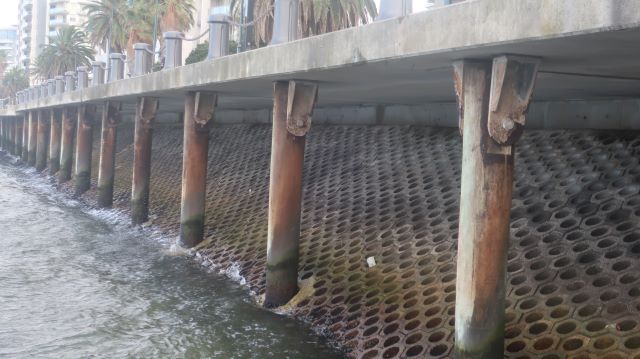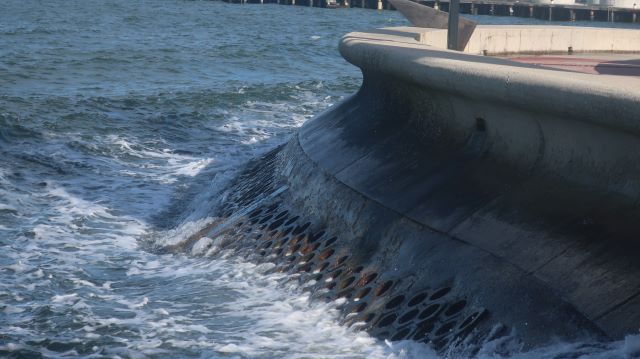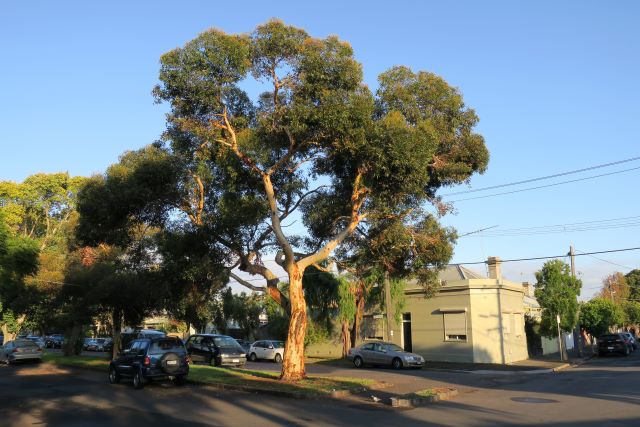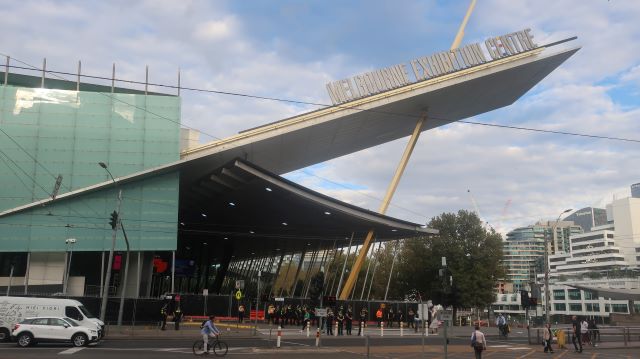Under the boardwalk in Beacon Cove
The boardwalk at the water’s edge in Beacon Cove, Port Melbourne, sits above a seawall – a Seabee seawall. It is made up of hexagonal shaped precast concrete units that fit together neatly.

The Seabee seawall dissipates wave energy. Waves run up the slope, water runs through the holes and back into the bay.
This video shows the way the seabees wall functions.
The seawall was constructed as part of Mirvac’s Beacon Cove development some time between 1996 and 2006. Over twenty years, facing wave action day in and day out, the seabees deteriorate.

The City of Port Phillip has engaged Contek, who have previously done repair work on the wall, to do further maintenance on the seabees. Contek fabricates the precast units off site, and re-installs those that need replacement. The pre-cast units have smooth surfaces, though Contek can vary the composition of the concrete. Waves and tides make the repair work challenging.
Maintaining the structural integrity of the wall to perform its role as the frontline of coastal defence for Beacon Cove is essential
Living Sea Walls, based in Sydney, is working to make coastal infrastructure more ‘ecologically enabling’. Coastal infrastructure such as piers, piles and marinas, is proliferating. Living Seawalls estimate that there is more hard infrastructure in the ocean than mangroves or seagrass. They see an opportunity to make those smooth surfaces ecologically active and more biodiverse. Blending their marine knowledge with the industrial design capacity of Reef Design Lab, habitat panels have been fabricated which are then affixed to coastal infrastructure. The habitat panels feature complex surface designs that mimic the natural environment. A reusable mould is made from the 3D printed panel. From this mould, concrete panels can be cast and manufactured in large numbers.
After 1-2 years Living Seawalls installed in Sydney Harbour already support at least 36% more species than plain, unmodified seawalls, with as many as 85 species of invertebrates, seaweeds and fish living and growing on the panels. Living Seawalls may also improve water quality as the oysters and mussels filter the water.1
Reef Design Lab has designed other novel projects in Victoria to repair and increase ecological diversity in the marine environment. Working with marine researchers and coastal managers, they bring creative and nature attuned approaches to coastal challenges. At Clifton Springs they have created the EMU (Erosion Management Unit) to reduce the force of waves and prevent further erosion of the beach. The EMU also optimises habitat for colonising species and creates snorkelling opportunities off shore.
Knowing the immense value of mangroves in coastal defence, they are experimenting in Altona and other locations, with mangrove planters.
Sounds like there is an opportunity exist to enhance the ecological performance of Beacon Cove’s seawall.
1Living Seawalls is a flagship programme of the Sydney Institute of Marine Science
Do visit the beautiful websites of Living Seawalls and Reef Design Lab to find out more about their work.
5 Comments
-
-
Linda N
Agree. I've walked past the sea wall for 20 years and now understand it so much better. It is great to see data being collected to make good decisions in these things - and innovative Australian companies showcasing and influencing government decisions.
-
-
Bitty
Fascinating post this week, inspiring to learn of innovative & environmentally enhancing solutions to sea wall defences. Thankyou for Port Places keeping us informed.




Anne Garrow
Very interesting Janet and the websites are fabulous. It is so encouraging to see the amazing ideas that people to protect the marine environment and develop habitat.